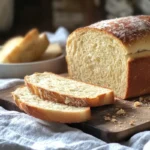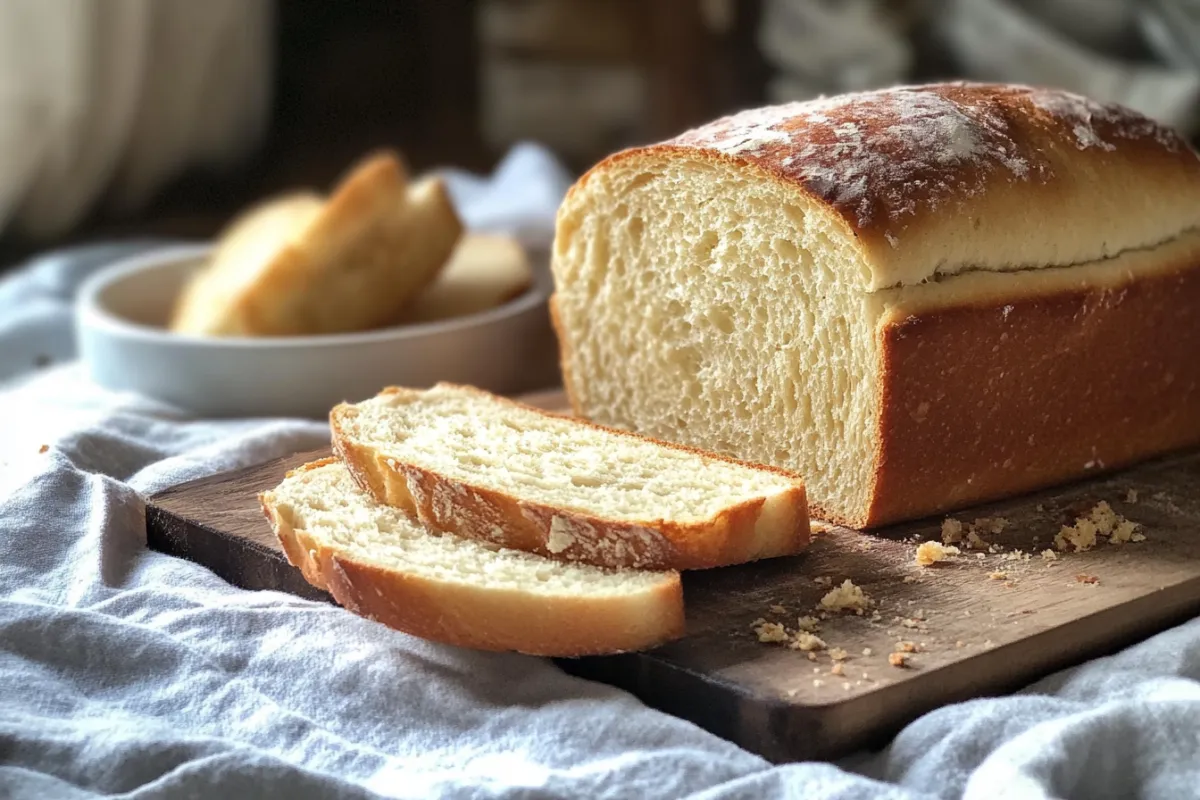Making a sandwich bread recipe at home is fun and makes sure you get a fresh, soft, and really tasty loaf. Forget the store-bought loaves that stay on shelves for weeks. When you make your own sandwich bread, you control the ingredients, freshness, and texture—it’s a total game changer.
In this guide, you’ll learn how to make the best sandwich bread recipe, understand the main techniques, and get helpful tips to make your bread extra fluffy and tasty. Baking bread at home might seem hard, but with a little practice and patience, it can be a relaxing and rewarding experience.
Why Make Your Own Sandwich Bread?
Homemade sandwich bread has many advantages over store-bought options:
- Better Ingredients: You can choose the best flour, the freshest yeast, and skip preservatives.
- Better Taste: Nothing beats the smell and flavor of freshly baked bread.
- Healthier Choice: Without additives or extra sugars, homemade bread can be healthier for you and your family.
Essential Ingredients for Your Sandwich Bread Recipe
Before you start, make sure you have all the ingredients you need. Here’s what you need:
- Flour: You can use all-purpose flour or bread flour for this recipe. Bread flour makes a chewier texture, which is great for sandwich bread.
- Yeast: Instant or active dry yeast works well, but make sure your yeast is fresh so the dough rises properly.
- Water & Milk: Warm water helps activate the yeast, and adding a little milk makes the bread softer.
- Sugar: A bit of sugar feeds the yeast and helps the bread rise, while adding a bit of sweetness.
- Salt: Needed for flavor.
- Butter or Oil: This makes the bread soft and gives it flavor, which is great for sandwiches.
Tips for Choosing the Right Ingredients
- Use organic flour when you can for a healthier loaf.
- Use filtered or bottled water if your tap water has strong flavors that could affect the dough.
- For a vegan version, use plant-based milk and olive oil instead of regular milk and butter.
Step-by-Step Guide to Making Sandwich Bread

To learn more about creating perfect sandwich bread, check out this Detailed Sandwich Bread Recipe from King Arthur Baking. This guide offers in-depth instructions and expert tips to help you achieve the best results at home.
1. Proofing the Yeast
Proofing is an important step in the sandwich bread recipe. To proof yeast:
- Mix warm water (around 110°F) with sugar and yeast.
- Stir gently and let it sit for about 5-10 minutes.
- The mixture should get frothy, showing that the yeast is active.
Tip: If your yeast doesn’t get frothy, throw it out and start again with fresh yeast.
2. Mixing the Dough
Mixing the dough well is important for gluten development. Here’s how to do it:
- Mix your flour, salt, and the yeast mixture.
- Add softened butter and mix until the dough forms a sticky ball.
You can use a stand mixer with a dough hook or mix by hand. Make sure the dough is slightly sticky, but not too wet.
3. Kneading the Dough
Kneading helps develop the gluten, giving your bread structure.
- If using a mixer, knead for about 5-8 minutes on medium speed.
- If kneading by hand, do it for about 10 minutes on a floured surface. The dough should be soft and stretchy but still a little sticky.
Kneading Tip: If the dough is too sticky, add a bit more flour, but be careful—too much flour will make the bread dry.
4. First Rise (Bulk Fermentation)
Let the dough rise in a warm, draft-free area until it doubles in size. This usually takes about 1-2 hours, depending on room temperature.
- Place the dough in a greased bowl, cover it with a clean kitchen towel, and let it rest.
5. Shaping the Dough
After the first rise, punch the dough down gently to release air.
- Turn it out onto a lightly floured surface, shape it into a loaf, and put it in a greased 9×5-inch loaf pan.
6. Second Rise (Proofing)
Let the shaped dough rise again in the loaf pan for about 30-45 minutes, or until it has doubled in size. This step is important for giving your bread that classic sandwich texture.
Baking Your Sandwich Bread
Preheat your oven to 375°F (190°C).
- Bake the bread for 25-30 minutes, or until the top is golden brown and the loaf sounds hollow when tapped.
- Let the bread cool on a wire rack before slicing.
Cooling Tip: Letting the bread cool completely helps it set properly. If you slice it while it’s still warm, it might be gummy inside.
Variations of Sandwich Bread
Whole Wheat Sandwich Bread
To make a healthier version, use half whole wheat flour and half all-purpose flour. Whole wheat bread is more nutritious but can be a bit denser.
Herb and Garlic Sandwich Bread
For extra flavor, add minced garlic and chopped herbs like rosemary or thyme. This version is great for savory sandwiches.
Sweet Sandwich Bread
Add a few tablespoons of honey or sugar for a slightly sweet bread, which is perfect for breakfast sandwiches or French toast.
Common Mistakes and How to Avoid Them
1. Yeast Issues
- Always make sure your yeast is fresh. Old yeast will not make the dough rise properly.
- Water temperature is important. If the water is too hot, it will kill the yeast; if it’s too cold, the yeast won’t activate.
2. Incorrect Measurements
- Use a kitchen scale to measure your ingredients for more consistent results.
- Don’t scoop flour directly with a measuring cup; use a spoon to fill the cup and level it off.
3. Over- or Under-Kneading
- Kneading helps develop gluten. Over-kneading can make the bread tough, while under-kneading will leave the bread flat and crumbly.
Storing and Freezing Sandwich Bread
Storing at Room Temperature
- Keep your sandwich bread in a plastic bag or bread box to keep it fresh for 2-3 days.
Freezing Instructions
- To freeze, wrap the bread tightly in plastic wrap, then in aluminum foil. It can be stored in the freezer for up to 3 months.
- To thaw, let it sit at room temperature, then reheat it briefly in the oven for a fresh taste.
Delicious Ways to Enjoy Sandwich Bread
Classic Sandwich Ideas
- Grilled Cheese: The buttery, crispy crust makes this sandwich a classic.
- Turkey and Avocado: Freshly baked bread pairs well with lean turkey and creamy avocado.
- Peanut Butter & Banana: A simple yet healthy choice that’s great for breakfast.
Pairing Bread with Soups and Stews
- Homemade sandwich bread is perfect for dipping into tomato soup or hearty stews.
FAQs on Sandwich Bread Recipe
What Makes a Good Sandwich Bread?
A good sandwich bread should be soft, slightly chewy, and strong enough to hold fillings without falling apart. The key is in the right balance of gluten development and moisture.
How Do I Make My Bread Softer?
- Adding a little milk or butter can make the bread softer.
- Don’t over-bake your bread, as this can make it dry and hard.
Can I Make Sandwich Bread Without a Stand Mixer?
Yes! Kneading by hand is a great alternative, though it may take more time and effort. It’s also a great way to practice your bread-making skills.
Nutritional Benefits of Homemade Sandwich Bread
Homemade bread usually has fewer additives and preservatives compared to store-bought bread, making it a healthier choice. Plus, you control the amount of sugar and salt, which is great if you’re watching your diet.
Final Thoughts
Baking your own sandwich bread recipe at home is a fun and rewarding experience that gives you a fresher, tastier loaf compared to anything from the store. With the right ingredients, techniques, and a bit of patience, you can enjoy homemade bread that’s soft, delicious, and perfect for all your favorite sandwiches.
Ready to give this sandwich bread recipe a try? Gather your ingredients, preheat your oven, and enjoy the magic of bread-making!
Print
Homemade Sandwich Bread
- Total Time: 60 minutes
- Yield: 1 loaf (about 12 slices) 1x
- Diet: Vegetarian
Description
Learn how to make a fresh, soft, and delicious sandwich bread at home.
Ingredients
- 4 cups all-purpose flour or bread flour
- 2 1/4 teaspoons instant yeast or active dry yeast
- 1 1/2 cups warm water
- 1/4 cup milk
- 2 tablespoons sugar
- 1 teaspoon salt
- 2 tablespoons butter or oil
Instructions
- Proof the yeast by mixing warm water, sugar, and yeast; let sit for 5-10 minutes until frothy.
- Mix flour, salt, and yeast mixture; add softened butter and form a sticky dough.
- Knead the dough for 5-8 minutes with a mixer or 10 minutes by hand until soft and stretchy.
- Let the dough rise in a greased bowl, covered, until doubled in size (1-2 hours).
- Punch down the dough, shape into a loaf, and place in a greased 9×5-inch loaf pan.
- Let dough rise again in the pan for 30-45 minutes until doubled.
- Preheat the oven to 375°F (190°C) and bake the bread for 25-30 minutes until golden brown.
- Cool on a wire rack before slicing.
Notes
For a vegan version, use plant-based milk and olive oil. Wrap bread tightly for storage and freeze if necessary.
- Prep Time: 30 minutes
- Cook Time: 30 minutes
- Category: Breads
- Method: Baking
- Cuisine: American
Nutrition
- Serving Size: 1 slice
- Calories: 120
- Sugar: 1g
- Sodium: 130mg
- Fat: 4g
- Saturated Fat: 2g
- Unsaturated Fat: 2g
- Trans Fat: 0g
- Carbohydrates: 20g
- Fiber: 1g
- Protein: 4g
- Cholesterol: 10mg
Keywords: bread, sandwich bread, homemade bread, baking

